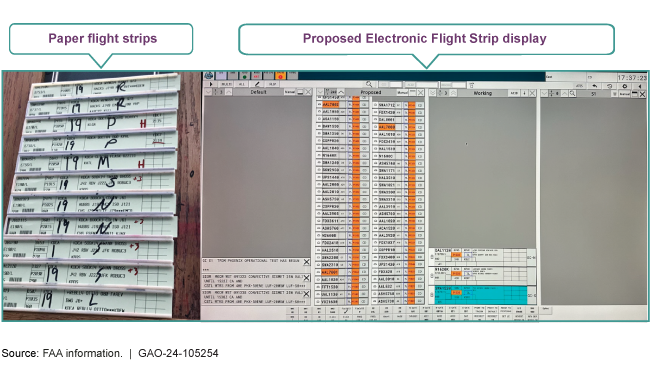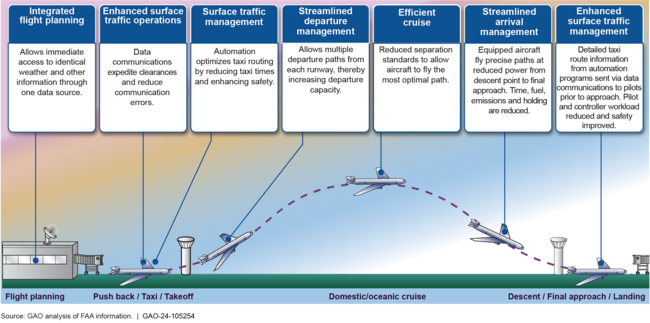Air Traffic Control Modernization: Program Management Improvements Could Help FAA Address NextGen Delays and Challenges
Fast Facts
The Federal Aviation Administration is improving the safety and efficiency of air travel by moving from a ground-based air-traffic control system that uses radar, to one based on satellite navigation and digital communications.
The NextGen program had a budget of $14 billion through 2022. In recent years, FAA has had mixed success in meeting program milestones, largely due to delays from the COVID-19 pandemic.
While FAA has used many leading program management practices to implement NextGen, it doesn't have a mitigation plan that identifies and prioritizes the biggest risks to the program. Our recommendations address this and other issues.
NextGen’s Terminal Flight Data Manager is an electronic system that will replace paper flight strips containing planned and current flight data

Highlights
What GAO Found
Since 2018, the Federal Aviation Administration (FAA) made mixed progress meeting milestones in its ongoing effort to modernize air traffic management, known as the Next Generation Air Transportation System (NextGen). This mixed progress, across four critical program areas, has slowed FAA's NextGen efforts to improve the safety and efficiency of air travel and address growing congestion in the national airspace. For example, FAA beat its milestone for deploying more reliable digital communication services at air traffic control towers. However, it did not deploy initial services to all 20 facilities serving en route flights by its September 2021 milestone. As of August 2023, FAA had not completed the deployment of those services at eight en route facilities. FAA also extended milestones for systems to improve flight spacing and sequencing. FAA reported that COVID-19 played a large part in missed milestones, delaying, for example, system testing and training.
Expected Improvements under the Next Generation Air Transportation System

FAA's efforts to implement NextGen fully or substantially met four leading practices for program management. For example, FAA has a lessons learned database and a program roadmap in line with these practices. However, closer adherence to five other practices could better position the agency to manage the program. For example, the agency has not updated NextGen life-cycle cost estimates since 2017. Doing so could help FAA better assess budget needs and refine annual budget requests, as well as measure its performance against the life-cycle cost estimate. In addition, FAA does not have a NextGen risk mitigation plan that identifies and prioritizes the highest programmatic risks or contains detailed risk alternatives analyses to mitigate identified risks. Such a plan could better equip FAA in its efforts to address the greatest risks and challenges to NextGen.
Why GAO Did This Study
NextGen is FAA's multi-decade program to increase the safety and efficiency of air travel by transitioning from a ground-based air-traffic control system that uses radar, to a system based on satellite navigation and digital communications. Through fiscal year 2022, FAA reported spending just over $14 billion on NextGen. FAA projected that it would cost the federal government and industry at least $35 billion through 2030.
GAO was asked to examine NextGen progress during the COVID-19 pandemic. Among other objectives, this report 1) describes FAA's progress in meeting NextGen 2018-2022 implementation milestones and how COVID-19 affected that progress and 2) examines the extent to which FAA's efforts to implement NextGen reflect program management leading practices. GAO focused on four critical stakeholder-identified NextGen program areas: navigation, communications, surveillance, and automation. GAO reviewed key NextGen plans, status updates, and performance reports. GAO also interviewed FAA officials and a range of aviation stakeholders to obtain diverse perspectives.
Recommendations
GAO is making four recommendations to improve FAA's management of NextGen. These address five leading practices and include (1) updating NextGen's life-cycle cost estimate and using it to measure performance, and (2) developing a detailed risk mitigation plan to help address challenges to NextGen implementation. FAA concurred with the recommendations.
Recommendations for Executive Action
| Agency Affected | Recommendation | Status |
|---|---|---|
| Federal Aviation Administration |
Priority Rec.
The FAA Administrator should develop an updated life-cycle cost estimate for NextGen, measure FAA's performance against it, and create a schedule for updating the life-cycle cost estimate regularly. (Recommendation 1) |
In October 2024, FAA provided us with an estimate of the cost NextGen up through 2025. In May 2025, FAA told us that it could estimate the costs of NextGen through 2030 but pending organizational changes related to the NextGen office and related changes in system names might make it difficult to make these estimates beyond 2030. We told FAA that fully addressing this recommendation would involve updating the costs beyond 2030 through the end of NextGen, including those NextGen systems that may be renamed. We also said that FAA needed to develop a schedule to regularly update these life-cycle cost estimates. FAA said they would discuss these issues and get back to us.
|
| Federal Aviation Administration | The FAA Administrator should develop and document a detailed risk mitigation plan focused on NextGen, which outlines how FAA identifies and prioritizes high-level risks to the NextGen program, provides alternatives for mitigation, and provides a rationale for the selected mitigation approaches. (Recommendation 2) |
In May 2025, FAA officials told us that they planned to develop the outline of a draft risk mitigation plan that used FAA's Active Risk Manager tool and risk register to roll up risks identified as high at the enterprise level. FAA would use either a qualitative or quantitative methodology to prioritize the highest risks at this level. The risk mitigation plan would provide alternatives for mitigation and provide a rationale for the selected mitigation approaches. We also discussed the importance of monitoring and updating the risk mitigation plan over a certain period of time, perhaps monthly or quarterly. We agreed with FAA that risk prioritization could be done at the enterprise (NextGen) level not at the program level because doing this for 30-40 NextGen programs would be difficult. We would review the draft risk mitigation plan outline and FAA would proceed with further development after receiving comments from us. FAA told us they would provide a draft risk mitigation plan within the next few months.
|
| Federal Aviation Administration | The FAA Administrator should ensure that its Acquisition Management System policy includes a requirement to conduct root cause analyses on individual NextGen programs that exceed a specific threshold of cost, schedule, or performance variance and when the program is rebaselined. (Recommendation 3) |
In October 2024, FAA provided documentation that showed how root cause analysis is now integrated in their Acquisition Baseline Management Standard Operating Procedure and provided a Business Case Template for Programs Requesting a Baseline Change Decision which shows how a root cause analysis is now part of this process. So, the documentation provided supports our recommendation that its Acquisition Management System policy includes a requirement to conduct root cause analyses on individual NextGen programs that exceed a specific threshold of cost, schedule, or performance variance and when the program is rebaselined. Specifically, the procedure includes a requirement to conduct root cause analyses on individual NextGen programs that exceed a specific threshold of cost, schedule, or performance variance and when the program is rebaselined. The template helps to reinforce this requirement when making a baseline change decision. As a result, FAA is better positioned to conduct more regular and systematic root cause analyses along with the development of corrective actions that may, in turn, help prevent other individual NextGen programs from experiencing similar cost or schedule overruns.
|
| Federal Aviation Administration | The FAA Administrator should include information in future NextGen Performance and Accountability reports to make clear which individual programs within NextGen are awaiting or have received revised cost, schedule, and performance goals, as well as those that FAA does not intend to rebaseline. (Recommendation 4) |
In May 2025, FAA officials told us that its Performance and Accountability Report no longer included a section that discussed whether NextGen programs were meeting cost, schedule, and performance. FAA officials explained that instead this info was provided as an appendix in its budget submission to Congress. This budget submission was transparent about when programs are rebaselined in addition to measuring whether they are meeting cost, schedule, and performance goals. We told FAA that we would review FAA's most recent budget submission to Congress to determine whether the submission was transparent about whether NextGen programs were meeting cost, schedule, and performance goals, including whether rebaselining had occurred.
|
